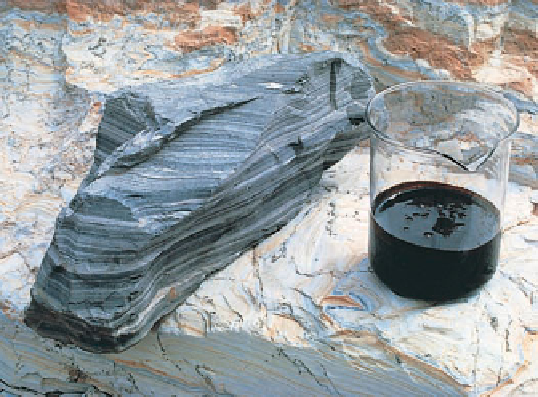Geology Reference
In-Depth Information
◗
Figure 6.29
Oil and Natural Gas The arrows in
a
and
b
indicate the direction of migration
of hydrocarbons.
Oil seep
Gas
Oil
Gas
Oil
Gas
Oil
Shale
Reef
Source
bed
Source bed
b
Two examples of structural traps: one formed by folding and the
other by faulting.
a
Two examples of stratigraphic traps: one in sand within shale
and the other in a buried reef.
c
The sedimentary rock oil shale (left) and oil extracted from it. The
United States has vast oil shale deposits.
of oil per ton of rock processed, and the total amount of oil
recoverable with present processes is estimated at 80 billion
barrels. Currently, no oil is produced from oil shale in the
United States because conventional drilling and pumping are
less expensive.
Tar sand is a type of sandstone in which viscous,
asphalt-like hydrocarbons fi ll the pore spaces. This substance
is the sticky residue of once-liquid petroleum from which
the volatile constituents have been lost. Liquid petroleum
can be recovered from tar sand, but for this to happen, large
quantities of rock must be mined and processed. Because the
United States has few tar-sand deposits, it cannot look to this
source as a signifi cant future energy resource. The Athabaska
tar sands in Alberta, Canada, however, are one of the larg-
est deposits of this type. These deposits are currently being
mined, and it is estimated that they contain several hundred
billion barrels of recoverable petroleum.
vanadium-bearing mineral
carnotite
, which is found in
some sedimentary rocks. Some uranium is also derived
from
uraninite
(UO
2
), a uranium oxide in granitic rocks and
hydrothermal veins. Uraninite is easily oxidized and dis-
solved in groundwater, transported elsewhere, and chemi-
cally reduced and precipitated in the presence of organic
matter.
The richest uranium ores in the United States are
widespread in the Colorado Plateau area of Colorado and
adjoining parts of Wyoming, Utah, Arizona, and New Mexico.
These ores, consisting of fairly pure masses and encrustations
of carnotite, are associated with plant remains in sandstones
that formed in ancient stream channels. Although most of
these ores are associated with fragmentary plant remains,
some petrifi ed trees also contain large quantities of uranium
(
Figure 6.30a).
Large reserves of low-grade uranium ore also are found
in the Chattanooga Shale. The uranium is fi nely disseminated
in this black, organic-rich mudrock that underlies large parts
of several states, including Illinois, Indiana, Ohio, Kentucky,
and Tennessee. Canada is the world's largest producer and
exporter of uranium.
◗
Most of the uranium used in nuclear reactors in North
America comes from the complex potassium-, uranium-,








































Search WWH ::

Custom Search